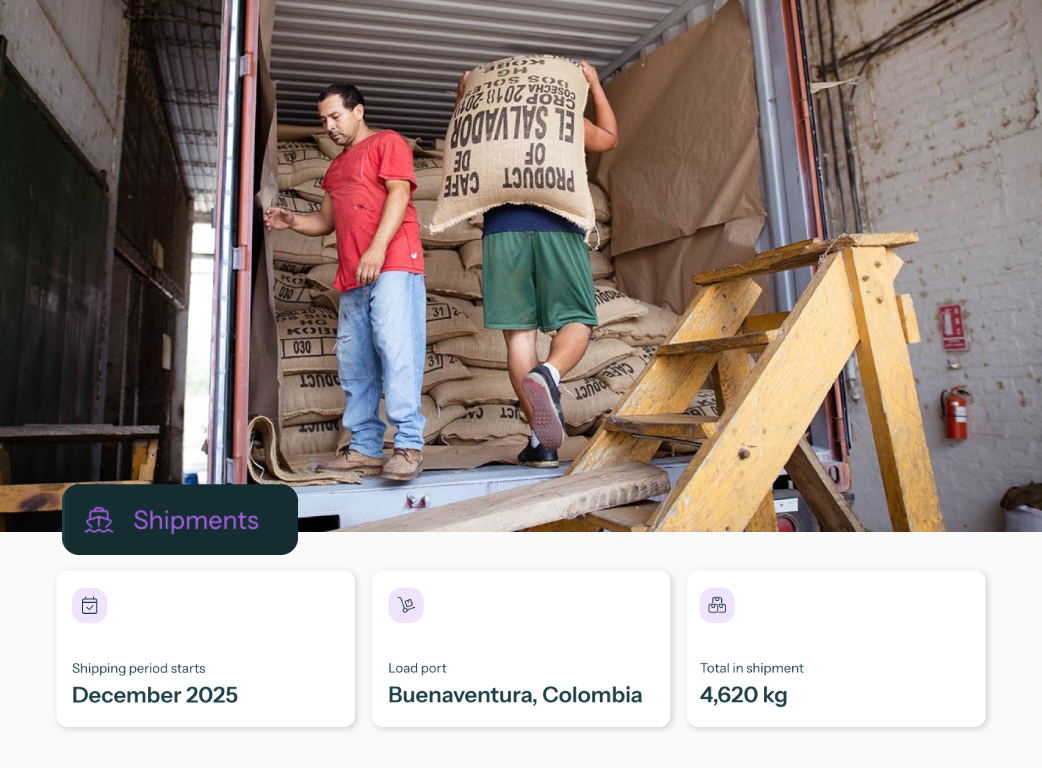Introduction
Most coffee producers today are making good coffee. Decades of investment in specialty have improved processing, varieties, and farm practices. So yes, your coffee is good for many different types of buyer.
But that doesn’t mean every buyer will be interested.
A good coffee salesperson knows how to find the right buyers for their coffees. And to do that, you need to start by understanding your coffees well. Not just the cup profile, but things like:
- How consistent it is
- How much you can supply
- When it ships
- What the story is
- How it solves problems for roasters
Having a pitch that goes beyond quality matters because, for any given “slot” on a roaster’s menu, they usually have dozens of coffees to choose from.
This is what the Algrano sales team does every day: they ask questions, they listen, and they match producers and roasters based on quality and communication style, and price expectations, and logistics, and values.

Algrano education
Algrano hosts a series of activities to share this kind of information with producers. For example, this October, he hosted a workshop at the Women Powered Coffee Summit, an event organised by Bean Voyage in Chiapas, Mexico. The idea was to help more producers build this skill: how to pitch to roasters confidently.
Our guest speakers were Nico Herr, Chief Operating Officer at Mountain Harvest (Uganda), and Luci Ramirez, Green Coffee Buyer at Humboldt Bay Coffee (USA).
They shared how they built their relationship and how Nico started selling to Luci with support from Algrano.
This post will share insights from the workshop. We’ll cover:
- What is a sales pitch?
- How to identify what makes you different from other producers
- The basic toolkit every producer needs
- How to know if a roaster is right for you
- How to manage communication with buyers
- A real example of how a successful relationship starts
1. What is a sales pitch?
A pitch is everything you do to help a buyer understand your coffee and decide to buy it.
Sure, we all wish that the coffee could speak for itself on the cupping table. Of course cup quality matters. But in most cases, that is just one piece of the process.
Before anyone signs a contract, there are usually several steps:
1. Getting to know each other
This is the discovery phase. You learn what the roaster needs. They learn what you can offer.
2. Tasting and comparing
This is the sampling phase. They taste your coffee alongside others and decide what could fit.
3. Planning the purchase
This is the negotiation and logistics phase. You talk about price, volumes, delivery dates, and how the coffee will move.
“A pitch is not one conversation. It’s many conversations,” says Nico. And to pitch well, you need to know how to talk about:
- Yourself
- Your coffees
- Your production volumes
- Your harvesting/shipping timelines
And most importantly: you need to ask good questions.
2. What makes you different?
A buyer doesn’t just buy coffee.
They buy:
- Reliability
- Consistency
- Story
- Timing
- Values and partnership
And remember: the competition is global. “The market is not only you and your neighbours. It’s other countries, and buyers have all of them on their email,” says Nico. If you don’t want to compete only on price, you need to explain your difference clearly.
Start with the basics:
- Where you are (be super specific!)
- Who you are (your family history)
- How you started (what drives you)
Then go one level deeper:
- Why do you produce coffee?
- What matters to you in this work?
- What are the three main values you stand by?
In sales, your differentiator is also called a “unique selling proposition”. It can be one sentence or a short paragraph, and it should be clear and personal. This helps buyers understand what problems you solve for them. And if you speak to themes they care about.
Examples of problems that producers often solve for buyers:
- Building their signature blends
- Finding good quality decaf
- Providing consistent quality consistently every year
- Providing coffees that can be roasted year-round (slow ageing)
- Bringing novelty to the menu
- Creating opportunities to educate workers and customers
- Winning customers by engaging them at events and online
- Planning through proactive communication
- Providing early and reliable shipments plus export support
To put it differently: you are not just “selling coffee”.
You are helping the roaster succeed at their business.
3. Putting your pitch on paper: the toolkit
Most pitches don’t happen in person. At least not only in person. They happen on email, WhatsApp, via text or voice notes.
So it really helps to have simple materials ready. And they don’t need to be perfect or fancy. They are just a starting point. We call this your basic sales toolkit. This can be on your website or as a PDF you can easily share digitally.
Your toolkit should include:
1. One-pager (your business “CV”):
- Who you are and where you are
- Key people in your team
- Your main values
- Your farming practices
- Your volumes
- Your harvest months
- Your unique story
- When samples are available
2. Offer list
Think of this like your catalogue. Even outside of harvest season, roasters want to know:
- Which coffees you produce regularly
- Approx. volumes
- Expected cup profile
- Processing methods
Then, during the harvest, you can share: FOB pricing table, current availability and the confirmed samples schedule.
And if you list offers on Algrano, your offer list will also include logistics and importing costs, making it even easier for the roaster to decide.
3. Export calendar
This is one of the most overlooked and powerful tools. Roasters plan months in advance. They need to know when your coffee will ship. If you can show this clearly, you already stand out.
4. How to know if a roaster is right for you
Just because every roaster buys coffee, it doesn’t mean every roaster is right for you.
If you want long-term relationships (not just one-off sales), it’s important to ask questions and learn about the roaster too.
Roasters need coffee for different reasons. These reasons relate to who their buyers are and where they sell.
- A roaster that sells coffee at the supermarket will have very different needs to a roaster who has their own chain of coffee shops.
- A roaster building a subscription business will look for different products compared to a roaster focused on wholesale coffee to restaurants and bars.
Chances are that you have coffee that works for different types of roasters. Most organisations do. But if a roaster is very strict about quality, ignoring that coffee is a living product, your experimental lot that ships in two months might not be the best fit. And that’s okay.
Key factors to pay attention to:
5. Managing the communication with a buyer
Roasters are often overwhelmed with emails and calls from people trying to sell them coffee. They might receive samples every day.
So your communication needs to be clear, precise, respectful of their time, and proactive.
On this subject, Nico suggests setting the expectations for future interactions at the end of every conversation. Let them know roughly when you’ll be back in touch and why.
She also emphasises the importance of asking permission to send samples. Roasters are served samples left and right and they know everyone wants to know what they think, so they often feel pressured.
Asking if you can send a sample and being very clear about what you're trying to learn from that feedback can help get them more excited about sharing their comments with you.
6. The roaster’s perspective: Humboldt Bay Coffee
Luci Ramirez shared her experience sourcing coffee for consumers in California. They value:
- Organic certification
- Affordable pricing
- Consistency
She also sells coffee in big grocery stores, where margins are tight and prices must be competitive. So Luci looks for:
- Volume stability
- Reliable shipment timing
- Coffee that works year after year
- A relationship she can grow over time
When she receives a pitch, the first questions she needs answered are:
- How much volume is available?
- Is the quality consistent?
- Is it certified organic?
- When will it ship?
- Can we repeat this next year?
This has nothing to do with how much she likes the coffee. It’s about planning and sustainability.
“When someone approaches me I really want to know the consistency, how much you have, when it’s going to ship. If you’re approaching me in January but you’re not going to ship until November, I need to know that. I can’t plan to use that coffee in my blend if it’s 10 months out and I need it in 3 months,” Luci explains.
7. How the Mountain Harvest x Humboldt Bay relationship started
.png)
Can a roastery like Humboldt Bay buy coffee from small producers? Sure they can! But their volume needs means they plan their sourcing way ahead of receiving the coffee. So they’ll want a clear overview of shipping timelines.
The first coffee Humboldt Bay bought from Mountain Harvest was a micro-lot. And that opened the door for a conversation about volume.
“A lot of the coffee we had at Mountain Harvest that fitted that queue [what Humboldt Bay needed] was a grade that was too expensive for Luci’s market. So listening to her story and her end consumer I saw the opportunity to design something in advance,” Nico remembers.
“Over the next season, I designed a coffee for her and ensured that, through our relationship, we could scale that over time. I went to our spreadsheets and understood, based on how many containers we were going to sell next year, that I could make sure all my B grade, or my screen 15, went to Luci. And as her company grew, our company grew.”
What this example shows is that, by looking at who the roaster’s end consumer is, you can find the right coffees and opportunities for growth.
8. Recap and next steps
Selling coffee directly to roasters isn’t about one message or one cupping. It’s a series of conversations where you learn about the roaster, help them learn about you, and work together to see if a partnership makes sense.
The goal isn’t just to sell to a roaster. Is to build a relationship where both sides can grow.
Your next steps are:
- Know what makes you different
- Prepare your sales toolkit
- Ask questions to understand the roaster
- Define the next steps after each stage of the sales process
- Think beyond the first sale
Remember: you’re not just selling coffee. You’re helping a roaster succeed. And they’re helping you succeed.
This is the core idea of direct relationships: shared planning and shared growth.



.png)
%201%402x.png)